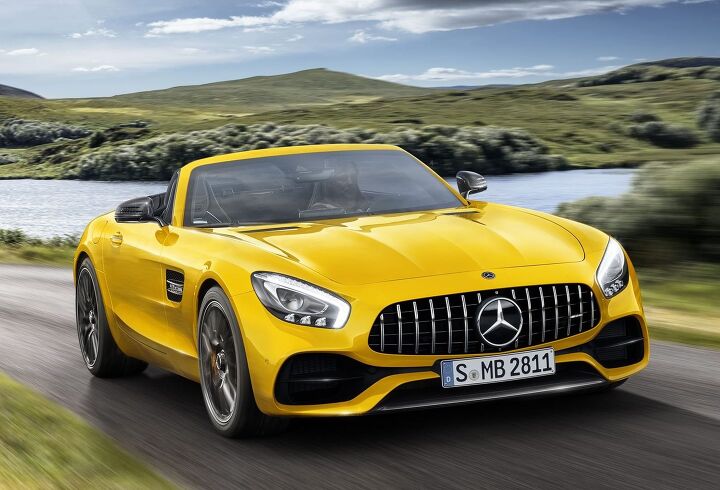2019 Mercedes-AMG GT S Roadster: The 515-horsepower Middle Child

The traditional birth order for children goes from oldest to youngest and biggest to smallest. But cars are a little different. If the market allows for it, you can slot in a middle child almost anywhere you like. Formerly a two-trimmed affair, the Mercedes-AMG GT Roadster is following the hardtop’s lead by expanding its ranks to include a middle-weight bruiser.
For the 2019 model year, AMG Roadsters will now come in a GT S trim. Better than the base unit, but not quite as impressive as its bigger brother, the formula for the mid-level trim is identical to the coupe variant that shares its name — just with an infinite amount of headroom.
The AMG GT and AMG GT C boast 469 horsepower and 465 lb-ft of torque, and 550 hp and 502 lb-ft, respectively. Slotting itself between them, the AMG GT S uses the same 4.0-liter biturbo V8 to produce 515 hp and 494 lb-ft. The combination is good for an 0-to-60 time of 3.7 seconds (estimated) and a top speed of 192 mph — splitting the difference between its siblings once more. That’s the predominant theme with the GT S. You’re getting more just about everywhere, but not so much to negate the GT C’s existence.
However, it’s closer than you might think. The GT S Roadster comes standard with AMG’s sports suspension with adaptive damping system, an electronically controlled limited slip on the rear axle, and variable performance exhaust — items which the base model lacks but come standard on the fancier GT C.
The two models also share multiple programable drive modes, including the “Race” setting that’s unavailable on the lower trim. But it lacks things like rear-wheel steering and has an interior with slightly less leather upholstery as standard. You can, of course, choose to upgrade.
An AMG high-performance composite brake system is obligatory. The front axle features composite discs measuring 15.4 x 1.42 inches, with six-piston fixed calipers, and 14.2 x 1.02 inch single-piston units at the rear. Mercedes will allow you to upgrade them to oversized high-performance ceramics, but we say pass unless you’re a track day junkie.
Standard wheels measure 19 inches up front and 20 in the back and come in a 10-spoke design. However, numerous designs are available for purchase. That might not be a bad investment either, because all three of the roadsters look practically identical. There are a handful of subtle tells, though.
Unlike the base model, the GT S comes with added chrome on the air inlet fins inside of the front bumper. There is also a little bit around the rear diffuser and front splitter. The red calipers are another giveaway. However, that doesn’t help much when trying to differentiate the mid-trim AMG from the GT C Roadster. All you can really do is hunt for more chrome around the lower portions of the bodywork.
Pricing hasn’t been announced yet but the 2019 Mercedes-AMG GT S Roadster has to be slotted in-between $124,400 and $157,000. We expect it to follow the coupe’s lead and be on the higher end of that spectrum, too.
[Images: Daimler AG]

A staunch consumer advocate tracking industry trends and regulation. Before joining TTAC, Matt spent a decade working for marketing and research firms based in NYC. Clients included several of the world’s largest automakers, global tire brands, and aftermarket part suppliers. Dissatisfied with the corporate world and resentful of having to wear suits everyday, he pivoted to writing about cars. Since then, that man has become an ardent supporter of the right-to-repair movement, been interviewed on the auto industry by national radio broadcasts, driven more rental cars than anyone ever should, participated in amateur rallying events, and received the requisite minimum training as sanctioned by the SCCA. Handy with a wrench, Matt grew up surrounded by Detroit auto workers and managed to get a pizza delivery job before he was legally eligible. He later found himself driving box trucks through Manhattan, guaranteeing future sympathy for actual truckers. He continues to conduct research pertaining to the automotive sector as an independent contractor and has since moved back to his native Michigan, closer to where the cars are born. A contrarian, Matt claims to prefer understeer — stating that front and all-wheel drive vehicles cater best to his driving style.
More by Matt Posky
Latest Car Reviews
Read moreLatest Product Reviews
Read moreRecent Comments
- Dr.Nick What about Infiniti? Some of those cars might be interesting, whereas not much at Nissan interest me other than the Z which is probably big bucks.
- Dave Holzman My '08 Civic (stick, 159k on the clock) is my favorite car that I've ever owned. If I had to choose between the current Civic and Corolla, I'd test drive 'em (with stick), and see how they felt. But I'd be approaching this choice partial to the Civic. I would not want any sort of automatic transmission, or the turbo engine.
- Merc190 I would say Civic Si all the way if it still revved to 8300 rpm with no turbo. But nowadays I would pick the Corolla because I think they have a more clear idea on their respective models identity and mission. I also believe Toyota has a higher standard for quality.
- Dave Holzman I think we're mixing up a few things here. I won't swear to it, but I'd be damned surprised if they were putting fire retardant in the seats of any cars from the '50s, or even the '60s. I can't quite conjure up the new car smell of the '57 Chevy my parents bought on October 17th of that year... but I could do so--vividly--until the last five years or so. I loved that scent, and when I smelled it, I could see the snow on Hollis Street in Cambridge Mass, as one or the other parent got ready to drive me to nursery school, and I could remember staring up at the sky on Christmas Eve, 1957, wondering if I might see Santa Claus flying overhead in his sleigh. No, I don't think the fire retardant on the foam in the seats of 21st (and maybe late 20th) century cars has anything to do with new car smell. (That doesn't mean new car small lacked toxicity--it probably had some.)
- ToolGuy Is this a website or a podcast with homework? You want me to answer the QOTD before I listen to the podcast? Last time I worked on one of our vehicles (2010 RAV4 2.5L L4) was this past week -- replaced the right front passenger window regulator (only problem turned out to be two loose screws, but went ahead and installed the new part), replaced a bulb in the dash, finally ordered new upper dash finishers (non-OEM) because I cracked one of them ~2 years ago.Looked at the mileage (157K) and scratched my head and proactively ordered plugs, coils, PCV valve, air filter and a spare oil filter, plus a new oil filter housing (for the weirdo cartridge-type filter). Those might go in tomorrow. Is this interesting to you? It ain't that interesting to me. 😉The more intriguing part to me, is I have noticed some 'blowby' (but is it) when the oil filler cap is removed which I don't think was there before. But of course I'm old and forgetful. Is it worth doing a compression test? Leakdown test? Perhaps if a guy were already replacing the plugs...







































Comments
Join the conversation
I agree 100% with Compaq Deskpro UGLY!
It could be better looking, for sure. Mercedes should look at its past roadsters to see what classic proportions and lines are. This looks like Hyundai had a say in its styling. I would prefer driving this over any other Benz, though. You couldn't actually drive it comfortably, though, unless you had a very expensive comprehensive insurance policy. Is it 4 times better than a Miata? Um, no. It just seems to scream "The guy driving this car is making an outrageous lease payment!" Around my town cars like this are only driven by status-competitive East Indians, and maybe an unmarried dentist or two.